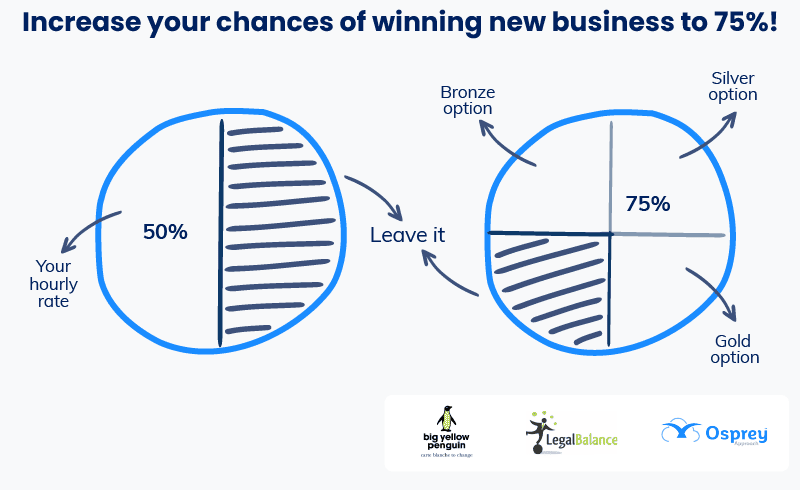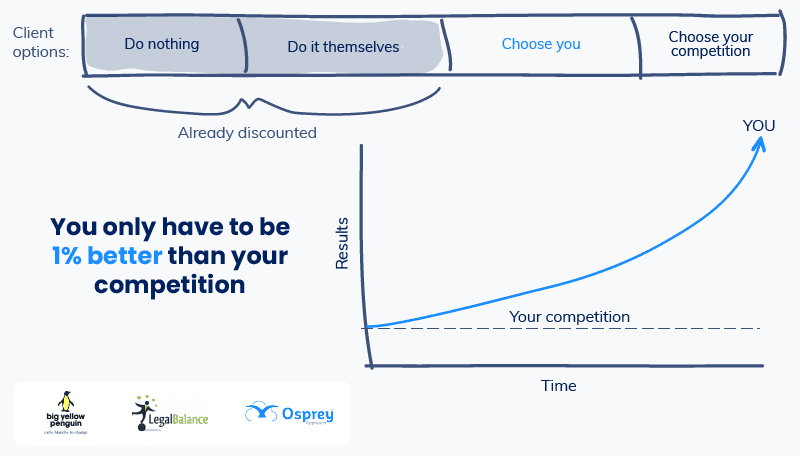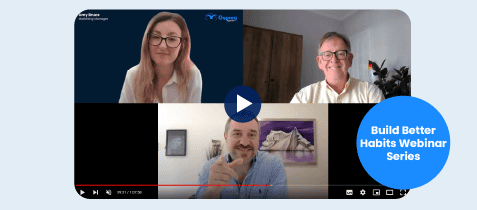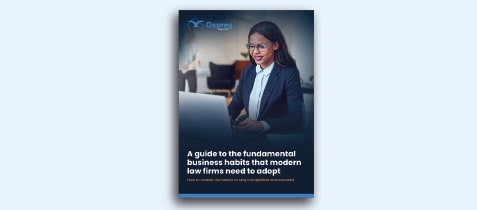Contents
Pricing models: Their role in helping modern law firms build a client-focused brand
In the second episode of series two of Build Better Habits, we were joined by Shaun Jardine, former CEO of Brethertons and now owner of Big Yellow Penguin and Scott Simmons, non-practicing solicitor and co-founder & director of Legal Balance. Our expert panel shared their practical advice and guidance on how to build a client-focused brand and effectively implement value-based pricing to enhance the client experience.

How is the client experience and brand linked?
Our panellists agreed that you can’t improve the client experience if your actions don’t align with your brand values.
Shaun began by defining what the term brand means: “You brand is what other people say about you when you’re not in the room. And how is that linked to the client experience? Well, it’s your clients who are talking about you.”
Shaun highlights that actions don’t often align with the values stated on a firm’s website: “When we look at a lot of law firms’ websites they’ll say, ‘we put the client at the centre of everything’ but if we’re not ringing them back or clients are chasing for updates then we’re not living up to those brand values.”
Scott agrees and recommends reading Simon Sinek’s book: Start with Why, where he states, ‘culture equals values plus behaviour’. As a starting point for firms, Scott suggests that there are, “certain questions you have to ask. These include ‘what are our values?’ and then once you know what they are, ‘are we actually living up to them?’ and ‘do we recognise and reward those values?’.”
Creating a strong brand builds a strong culture because everyone is pulling in the same direction. However, Scott warns of toxic behaviours: “[There are] often people in the firm who are toxic to the culture but we keep them because they’ve been here for a long time or they’re high ‘performers’. Your values should matter more than anything else.”
Scott then highlights how a firm’s values can be undermined by their pricing models. “The hourly rate is the predominant business model at the moment but it doesn’t align with the values that lawyers and firms claim they have. And often, the number one metric of success is the number of hours billed – again, that doesn’t align with values.”
What does the term ‘value’ mean and why should firms consider value-based pricing?
The champion of value-based pricing (VBP), Shaun, starts by defining what it means: “Value-based pricing is no more than getting a fee that is fair to the firm and to the client for the value that lawyers create.
“Value is subjective, contextual, and isn’t rational. Value is a feeling and a great example of that is the [TV] show The Repair Shop. They fix tatty old teddy bears or old leather briefcases for people because of the sentiment, memories, and feelings attached.
“Clients aren’t buying your expertise or time. They’re buying the house of their dreams, or the ability to sleep soundly at night.
“That’s why the fee you charge clients shouldn’t be about the six minutes it takes me to tell you my advice, it has to reflect the value I can provide you.”
Scott agrees that lawyers don’t sell time and explains why that is not a helpful mindset for running a client-focused, profitable business. “The idea that lawyers sell time is ridiculous. We don’t sell time – because the implication is that it’s fine to be penalised for being quick at your job.
“If we sell time then we want it to take as long as possible. But is that what clients want if we’re looking to be a client-focused brand? Clients shouldn’t be looking at timesheets. An hourly rate does not speak about value at all.”
How does a firm’s pricing model impact the client experience and their brand?
Our panellists highlight how the traditional billable hours pricing model is hindering a firm’s chance to offer a truly client-focused service because it doesn’t align with the clients’ need for transparency, speed, and personalisation. First, Shaun discusses how the hourly pricing model is – literally – halving a firm’s chance of winning new business in the first place.
“I’m a great believer in creating options. If your current options to clients are: ‘this is my hourly rate, take it or leave it’ then you have a 50% success rate. If you give three options – such as gold, silver, or bronze – and the fourth option is leave it then you’ve got a 75% chance of clients selecting you.”

The only way firms can offer options is if they know what’s of value to the client. Shaun emphasises the importance of not assuming what clients want: “You have to have a conversation to find out what is valuable and what’s important to the client.”
Asking the right questions at the outset helps you plan and scope a case effectively. “Scoping is so important because it shows you’ve understood the problem,” says Shaun. Scott agrees and continues, “VBP works because everything is discussed upfront. Scope creep is just a fear of picking up the phone. But when you set boundaries and outline how you’ll work with clients you’ll avoid write offs.
“Lawyers say they don’t have time to scope but then write-off time at the end. The average write off across the sector is 15-20% of the bill. When you get the scoping right and set expectations you don’t have write offs.”
Because value is subjective, you have to present the value of your services in a way that your clients will understand. Shaun explains his success in winning work that was double the competitor’s costs: “Back in the day I won a client, at double the cost, because he said, ‘you really thought about my case’. I hadn’t really, but I had put all my plans and considerations, even images of the people who will work with them, in a scoping document. Competitors had only sent a letter with a single paragraph with the cost.”
Shaun explains that clients have four options: do nothing, do it themselves, instruct you or instruct your competitors. “If they’ve picked up the phone they’ve discounted the first two options.” So improving your service by just 1% better than the competition can have big impacts on winning and retaining clients.

Six habits law firms should adopt to ensure you have a client-focused brand
The panel agreed that modern law firms should focus on the following habits to build a client-focused law firm:
1. Prioritise innovation
Shaun recommends firms should “make it a strategic objective to do something different.” It’s important to free up time to reflect and review on how things are currently done to create a genuine differentiator that your target clients appreciate and value.
2. Get pricing on the agenda
Your pricing model and your client experience are intrinsically linked, so leaving fees to chance hinders your ability to build a truly client-focused brand. Shaun shares his experience; “Pricing is never on the board agenda or in team meetings. I always ask firms that I work with, ‘when a new starter joins, how is the pricing induction dealt with?’ and 50-60% of the time people say that it isn’t.
“Pricing is typically dealt with in silos where people do their own thing,” which isn’t effective for clients or the business’s bottom-line.
3. Train your lawyers
Scott explains that lawyers aren’t taught to have commercial conversations with clients. “Remember you are in a business that sells legal services. You have to train your lawyers if you want them to be truly client focused.”
4. Proactively communicate
Scott shares his thoughts on good communication: “If you want to build strong value-creating relationships, you have to be able to effectively communicate. And not everyone is a natural communicator. Communication is not just about speaking; it’s listening and asking questions. Show that you’re genuinely interested and clients will love you for it.”
5. Capture regular client feedback
Feedback is at the core of continuous improvement. Scott reassures firms that receiving negative feedback isn’t bad for the business. “If clients say something bad about your firm it’s an opportunity to learn. If clients aren’t saying the bad things to you then they’ll be telling 10 other people anyway. You can’t improve what you don’t know.”
6. Sack your bad clients (politely)
Knowing what clients you don’t want is just as important as recognising the ones you do when it comes to your firm’s success. Shaun advises that firms, “sack your bad clients. Your lawyers know who is awful to deal with and who is unprofitable. Let those people distract your competitors instead.”
Align your values with your behaviours and pricing model to build a client-focused brand
At the core of all client-focused brands is listening. Listening to customers’ needs and feedback to tailor the best service. Clients want to be heard, understood and feel like you’re on their team. Asking the right questions, avoiding assumptions, and being curious is the behaviours of a client centric team.
If you want to build a culture that’s focused on the client you have to set values that all employees live by. A common purpose that is collectively agreed to and that daily habits and behaviours reflect, as well as success measure that reward those values and hold employees accountable.
But that level of service requires the right fee. Knowing your worth and delivering a quality service needs to be costed accordingly to ensure a healthy business. This requires teams to have the confidence and training to set expectations at the outset, avoid scope creep by proactively communicating, and avoiding write-offs so employees’ time is valued.
To get exclusive advice and guidance on building a client-focused brand and adopting VBP, watch the full episode on-demand now. In the webinar, Shaun and Scott share more about their experiences and answer attendee questions including:
- Should we show clients timesheets when doing VBP?
- How do we manage scope creep when we don’t know what will happen?
- Should we give fixed and hourly rate options to clients?
Being client-focused is one of the four fundamental habits we’ve outlined that all modern law firms should adopt for long-term success. We’ve covered all four habits in our Build Better Habits webinar series, which you can watch on-demand now.





